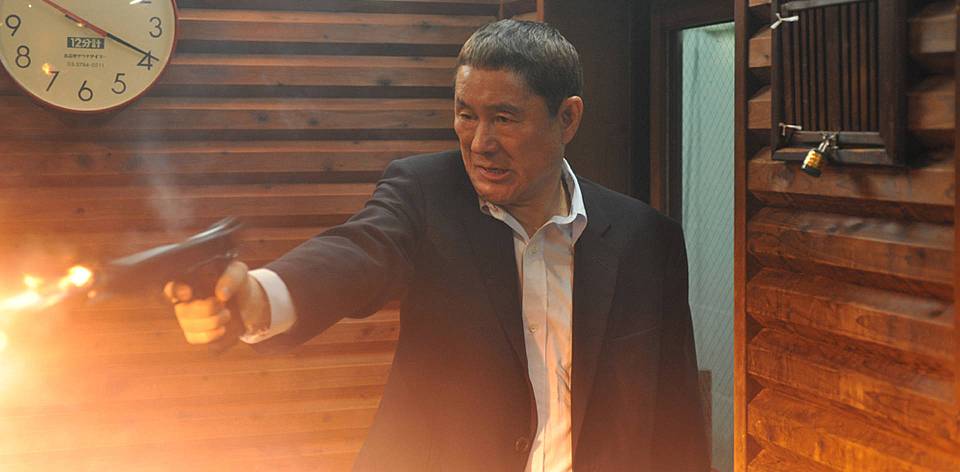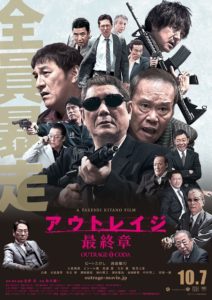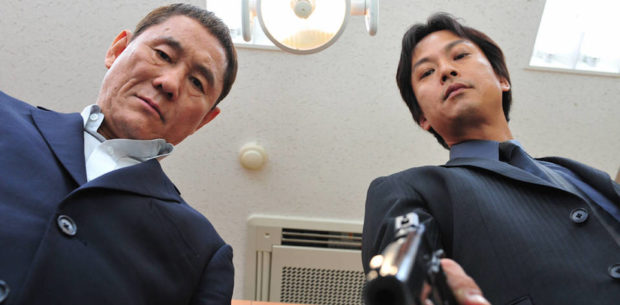OUTRAGE CODA (アウトレイジ 最終章), the third and final chapter in ‘Beat’ Takeshi Kitano’s Outrage Trilogy, opens on a deceptively lighthearted comedic note about fishing, kimchi, and gunplay. Yet the sense of foreboding one feels is not just informed by its dark predecessors, but by the violent revenge play that is moments away from unfolding.
Set sometime after the events of Outrage Beyond, Otomo (Kitano) is now isolated on Korea’s Jeju Island, working for the local boss Chang (Tokio Kaneda). Holidaying yakuza Hanada (Pierre Taki), a middling level member of the Hanabishi clan, roughs up some of Chang’s prostitutes. Naturally, Otomo is sent in to sort him out. Following the death of one of Otomo’s loyal henchman at the hands of Hanada, the aging Otomo and sidekick Ichikawa (Nao Omori) find themselves back in Japan in the middle of a power struggle with the Hanabishi.
In more ways than one, OUTRAGE CODA represents the last dying gasps of the old guard. After the departure of the prostitutes in the opening scenes, nary a woman is to be seen for the duration of this old boys’ club. This whole film is the representation of a way of life that no longer serves a purpose in modern Japan, and Otomo is a still breathing personification of that era. For Kitano the filmmaker, he is writing a literal coda to themes he has been playing with since at least 1993’s Sonatine.
Otomo is a constant presence in the film, but his screen time is metered out, just as was the case in the first two entries. As soon as he lands back in Japan there is a dynamic tonal shift, both in the film and the interplay between the principal yakuza. Every moment he spends on screen is pure joy, perhaps matched only by Tokio Kaneda’s phenomenally beleaguered face and anachronistic series of tycoon vests.
Even though the film carries an extremely measured pace, the series comes to a conclusion with bursts of frenzied violence. The glorified shooting up of a convention has more bloodletting than all three Outrage films combined, and has strange parallels to The Godfather Part III. It’s hard to see this kind of expected casual gunplay as entertainment in 2017, and perhaps a sign that this particular brand of action is going the same way of the on-screen crooks.
“That old fashioned gangster definitely served us well,” remarks Nishino during the climax of the film. For Otomo and Kitano alike, truer words were never spoken. Otomo’s cinematic exit is as pragmatic as Kitano’s approach to his final film. There are no happy endings to be had here, but Kitano has still managed to create something that is greater than the sum of its bloodied parts.
 2017 | Japan | DIR: Takeshi Kitano | WRITERS: Takeshi Kitano | CAST: Takeshi Kitano, Toshiyuki Nishida, Tokio Kaneda, Nao Omori | DISTRIBUTOR: Adelaide Film Festival (AUS) | RUNNING TIME: 109 minutes | RELEASE DATE: 7 October 2017 (Japan), 14 October 2018 (ADLFF)
2017 | Japan | DIR: Takeshi Kitano | WRITERS: Takeshi Kitano | CAST: Takeshi Kitano, Toshiyuki Nishida, Tokio Kaneda, Nao Omori | DISTRIBUTOR: Adelaide Film Festival (AUS) | RUNNING TIME: 109 minutes | RELEASE DATE: 7 October 2017 (Japan), 14 October 2018 (ADLFF)






